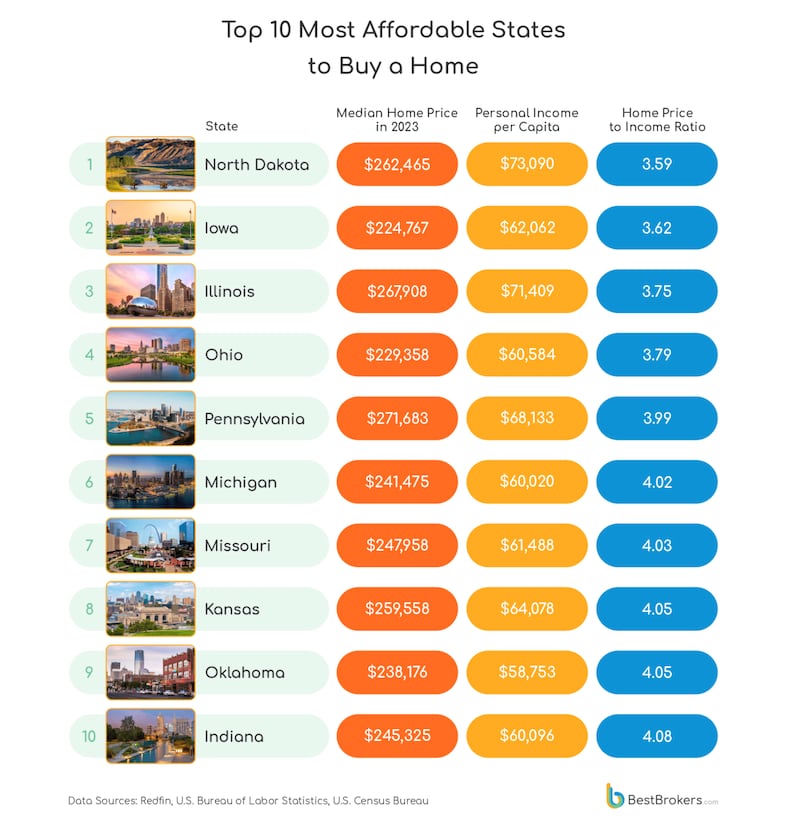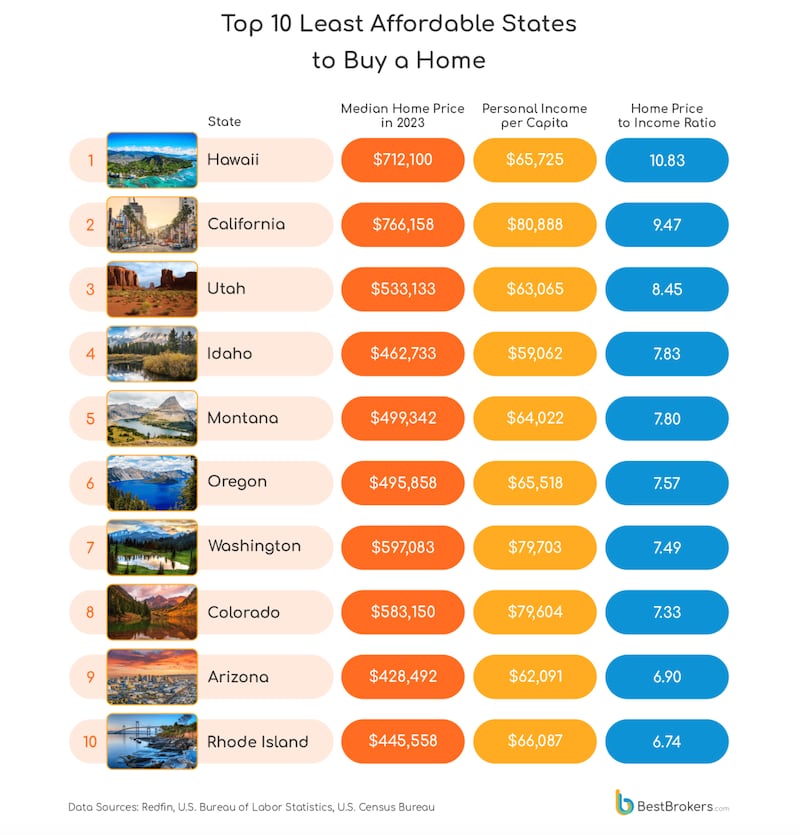If you’re looking to finally buy a house this year, you might find the market as unyielding in 2024 as it has been for the past several years.
High mortgage rates, rising construction costs, a limited housing supply amid surging demand and lingering post-pandemic implications are most likely to make the housing market a tough one, especially for young Americans. But when the ratio between home price and income is taken into account, some states offer relatively affordable housing options, according to a new analysis by BestBrokers.com.
The U.S. median home sale price hit $408,428 in 2023, while the per capita income totaled $68,786 as of the third quarter. That equates to the median house price being almost six times a person’s annual salary, the study found.
Using data from Redfin, BestBrokers analyzed median home sale prices for all residential properties across the U.S. in 2023. To determine how much savings it would take the average American to buy a home in each state, the firm correlated those prices with per capita personal income figures for the third quarter of the same year using the U.S. Bureau of Economic Analysis. It then ranked the states based on home affordability, coming up with a list of the 10 most and least affordable states for prospective homebuyers.
Eight of the top 10 most affordable states are in the Midwest, with median home prices under $300,000, making them relatively accessible based on per capita income, according to BestBrokers. Conversely, the states with the highest price-to-income ratio — eight of the top 10 are in the West, including Utah — are well beyond the budget of most Americans, including the ones living in them.
Most affordable states to buy a home
North Dakota had the lowest price-to-income ratio on the list at 3.59, meaning residents would need to save their salaries for three years and six months to cover the cost of a home. With a median home value of $262,465, well below the national median, and an income per capita averaging $73,090 (the highest among the top 10 most affordable list), according to BestBrokers.
Iowa had the second most affordable housing options, showing a median home price of $224,767, the lowest nationwide, and a per capita income averaging $62,062 for a ratio of 3.62. Illinois came next in affordability, with a median home value of $267,908 against a per capita income of $71,409.
Rounding out the top 10 most affordable are Ohio, Pennsylvania, Michigan, Missouri, Kansas, Oklahoma and Indiana.

Least affordable states to buy a home
Hawaii ranked as the least affordable state to buy a home, with a median housing cost of $712,100, nearly double the national average and a per capita income of $65,725. With an average salary, it would take more than 10 years to save for a home, according to BestBrokers.
With median prices soaring to $766,158, California residents face the priciest housing costs in the country. Despite having the highest per capita income on the least affordable list ($80,888 per year), those living in the Golden State barely make 10.56% of their housing cost per year, resulting in the second-highest price-to-income ratio on the list at 9.47.
Utah landed near the top of the country’s most expensive real estate markets, ranking third-highest in terms of home price-to-income ratio. A person’s median annual income ($63,065) only accounts for 11.83% of the expense of buying a home in the Beehive State at a median price of $533,133, the report showed.
The rest of the top 10 least affordable are Idaho, Montana, Oregon, Washington, Colorado, Arizona and Rhode Island.

Wages not keep pacing with home prices
Home values remained high throughout much of 2023, though there was noticeable decline at the end of the year, Redfin reported. But the drop doesn’t necessarily equate to increased affordability as housing prices remain at near record highs, with no market crash in sight, as some experts had previously predicted, according to BestBrokers.
Last year, existing property sales fell to their lowest level in nearly 30 years, while the median price surged to historic highs, according to a recent report by the National Association of Realtors. Although personal income has gone up since the 2000s, it hasn’t kept pace with the home prices. From 2000 to 2023, median income in the U.S. increased by 63.82%, from $41,990 to $68,786 a year, while the median home price skyrocketed by 241.49%, from $119,600 to $408,428, per the latest U.S. Census Bureau data.
The average age of homebuyers has also risen to 44 years old, compared to 25-34 in 1981, BestBrokers noted. In the past, people were more able to afford mortgages as borrowing rates were low but that is no longer the case. The dollar had an average inflation rate of 2.46% per year between 2000 and today, producing a cumulative price surge of 79.10%. Consequently, today’s prices are 1.79 times higher than the average prices since 2000, as per the Bureau of Labour Statistics consumer price index.


